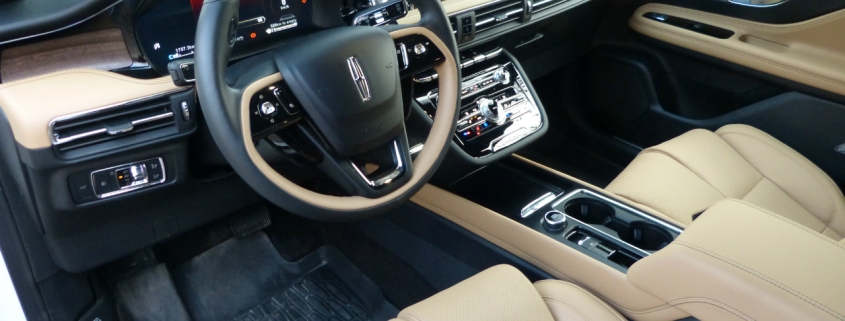Review: 2021 Lincoln Corsair
With about a million high-end SUVs available, how does a customer make a rational decision? More to the immediate issue, how does a product reviewer like me come up with a recommendation?
These thoughts came to mind while I was testing the Lincoln Corsair. It launched as a 2020 model, aiming at similarly-speced vehicles from such as Audi, BMW, Cadillac, and Mercedes-Benz.
The 2021 Corsair starts at $42,700, and can rise rapidly to the $63,800 sticker of my tester.
Mine checked just about every box on the order form, except it had the base 2.0 litre twin-turbo four cylinder engine (250 horsepower at 5,500 r.p.m.; 280 lb.-ft. of torque at 3,000 r.p.m.) rather than the 295-hp 2.3.-litre four-pot. The larger engine would give decidedly better acceleration, and gets almost the same fuel consumption scores, but adds $8,500 to the bottom line. Yikes.
The eight-speed automatic transmission powers all four wheels; the front-drive variant is not available in Canada.
Corsair is built on the same 2,710 mm wheelbase as Ford’s Escape. Hence, it’s a five-seater, and shares its body structure, technology, and some powertrains. But seldom have two such closely related vehicles yielded a wider range of results. The difference you’ll notice immediately is the interior ambience. High-quality materials abound, including real tree wood and luxurious-looking leather. As usual with compact-to-mid-size SUVS, there’s decent room for four, with a third rider in the rear a possibility.
Consistent with current Lincoln practice, the transmission controls are a series of push buttons on the dashboard. This actually makes more sense than tying up valuable real estate on the centre console that is more wisely turned over to cup holders and odd-and-sods storage. There are proper round knobs for sound system operation. It will take some time to figure out which buttons and knobs do which functions, but that’s the case with any new vehicle.
The steering wheel heater and seat heating (and cooling) controls are easily found in the centre stack, so there must be a Canadian in Lincoln’s interior design department somewhere. The head-up display shut-off switch is also handy if, like me, you’d rather be looking at the road than be constantly distracted by lights flashing in the windshield all the time. Blind spot detection and lane keep assist systems are also included. Useful technology such as built-in WiFi, Apple CarPlay and Android Auto capability are part of the package, as well as cross-traffic alert, pre-collision assist with automatic emergency braking, and a rear view camera with multiple screen layouts including a bird’s eye view, handy when backing up. The popular Waze app provides a good supplement to the SatNav system.
Seat adjustment is by buttons on the door panel that look almost identical to those Mercedes introduced many years ago. Push the part of the button that corresponds to the part of the seat you want to adjust, and Bob’s your uncle. It took me a while to find the right seating position.
Lincoln has introduced a number of functions to make servicing your vehicle easier. A 1-800 number connects you to a “concierge”, which as in a top-class hotel, will look after myriad details to make your experience less stressful. Self-parking, both parallel and perpendicular, are there if you want to use them.
Using the “Lincoln Way” app on your smartphone, you can also schedule routine maintenance remotely. They’ll even pick your vehicle up and leave you a loaner. Sadly, I don’t get to test vehicles for long enough to tell you how well this works. I’m ready when you are, Lincoln.
What I can tell you a bit about is how the vehicle performs, rides and handles.
In short, surprisingly well. Even the smaller engine provides Corsair with decent acceleration, and the twin turbo takes care of any hint of turbo lag. The transmission shifts almost imperceptibly. Paddle shifters are available if you think you can do better.
The “Adaptive Suspension” ensures a serene ride, as sensors adjust damping in milliseconds in response to steering or braking manoeuvres, or changes in road surface quality. “Handling”, a word not often associated with Lincolns, is better than expected, with decently flat cornering and steering that is precise, if perhaps a bit too light for my taste. A “Drive Mode” knob offers various settings. The parenthetical comments following each one here pretty much tell the story: Normal (effortless and balanced); Conserve (efficient driving); Excite (responsive and engaging); Slippery (slick, icy, and loose surfaces); Deep (deep snow, mud or sand).
Throttle, suspension and transmission responses vary to suit, and the differences between the settings are larger, more noticeable, than in most such systems. Each setting has a unique instrument cluster layout. “Deep” also shuts off traction control because sometimes you need a bit of wheel spin to get you out of the mud. I didn’t do any boonie-bashing, so I kept it mostly in Comfort and Excite.
Corsair is also commendably quiet. Good sound insulation is at work here. Lincoln is now an SUV-only brand, as the big and impressive Continental and the mid-size MKZ sedans are done. Regular readers know I’m not much of a fan of SUVs, so I didn’t come into this test with high hopes. If an SUV can pleasantly surprise me, it must be doing something right.
The vehicle was provided to the writer by the automaker. Content and vehicle evaluations were not subject to approval.
The post Review: 2021 Lincoln Corsair appeared first on WHEELS.ca.



